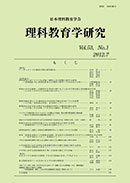Volume 51, Issue 2
Displaying 1-14 of 14 articles from this issue
- |<
- <
- 1
- >
- >|
Original Papers
-
2010Volume 51Issue 2 Pages 1-9
Published: November 05, 2010
Released on J-STAGE: June 30, 2021
Download PDF (882K) -
2010Volume 51Issue 2 Pages 11-19
Published: November 05, 2010
Released on J-STAGE: June 30, 2021
Download PDF (1469K) -
2010Volume 51Issue 2 Pages 21-27
Published: November 05, 2010
Released on J-STAGE: June 30, 2021
Download PDF (875K) -
2010Volume 51Issue 2 Pages 29-39
Published: November 05, 2010
Released on J-STAGE: June 30, 2021
Download PDF (1227K) -
2010Volume 51Issue 2 Pages 41-51
Published: November 05, 2010
Released on J-STAGE: June 30, 2021
Download PDF (1397K) -
2010Volume 51Issue 2 Pages 53-63
Published: November 05, 2010
Released on J-STAGE: June 30, 2021
Download PDF (1288K) -
2010Volume 51Issue 2 Pages 65-75
Published: November 05, 2010
Released on J-STAGE: June 30, 2021
Download PDF (1284K) -
2010Volume 51Issue 2 Pages 77-88
Published: November 05, 2010
Released on J-STAGE: June 30, 2021
Download PDF (1493K) -
2010Volume 51Issue 2 Pages 89-98
Published: November 05, 2010
Released on J-STAGE: June 30, 2021
Download PDF (1243K) -
2010Volume 51Issue 2 Pages 99-108
Published: November 05, 2010
Released on J-STAGE: June 30, 2021
Download PDF (1112K) -
Article type: Article
2010Volume 51Issue 2 Pages 109-124
Published: November 05, 2010
Released on J-STAGE: June 30, 2021
Download PDF (1837K) -
2010Volume 51Issue 2 Pages 125-133
Published: November 05, 2010
Released on J-STAGE: June 30, 2021
Download PDF (1067K)
Note
-
2010Volume 51Issue 2 Pages 135-140
Published: November 05, 2010
Released on J-STAGE: June 30, 2021
Download PDF (733K)
Forum
-
2010Volume 51Issue 2 Pages 141-142
Published: November 05, 2010
Released on J-STAGE: June 30, 2021
Download PDF (328K)
- |<
- <
- 1
- >
- >|
